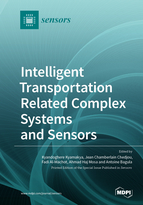Intelligent Transportation Related Complex Systems and Sensors
A special issue of Sensors (ISSN 1424-8220). This special issue belongs to the section "Intelligent Sensors".
Deadline for manuscript submissions: closed (31 July 2020) | Viewed by 94245
Special Issue Editors
Interests: intelligent transport systems; telecommunications; neuro-computing; machine learning and pattern recognition; nonlinear dynamics
Special Issues, Collections and Topics in MDPI journals
Interests: analog computing; dynamical systems; neuro-computing with applications in systems simulation and ultra-fast differential equations solving; nonlinear oscillatory theory with applications; traffic modeling and simulation; traffic telematics
Special Issues, Collections and Topics in MDPI journals
Interests: machine learning; pattern recognition; image processing; data mining; video understanding; cognitive modeling and recognition
Special Issues, Collections and Topics in MDPI journals
Interests: machine learning; cognitive neuroscience; applied mathematics; machine vision
Special Issues, Collections and Topics in MDPI journals
Interests: internet-of-things; artificial intelligence; blockchain technologies; next generation networks
Special Issues, Collections and Topics in MDPI journals
Special Issue Information
Dear Colleagues,
Transportation systems are particularly complex systems as they are mostly “systems of complex systems”. Complex systems are characterized by specific time-dependent interactions among their many constituents/sub-systems/components. As a consequence, they often manifest rich, non-trivial and unexpected behaviour.
Examples of transportation-related complex systems are: road traffic, traffic sensors, autonomous/automated cars, smart cities, smart sensors, virtual sensors, traffic control systems, smart roads, logistics systems, smart mobility systems, etc.
For the mastering and efficient operation of various transportation-related complex systems, a series of sensor/sensing, data quality, online simulation, and modeling and optimization related issues are of extreme high actual interest.
Selected Keywords:
- Complex systems concepts in transportation
- System dynamics based modeling and simulation in transportation
- Online simulation and virtual sensing in intelligent transportation
- Online (spatio-temporal) traffic modeling (system identification) in relation with virtual traffic sensors
- Safety performance assessment based on virtual experiments
- Virtual sensors design principles
- Virtual sensors modelling techniques
- Sensor clouds in transportation
- Cloud virtual sensors in transportation
- Virtual sensors modelling using neural networks and/or deep learning
- Self-learning virtual sensor networks in intelligent transportation
- Compressive sensing for physical and virtual sensors
- Sensor data quality modeling and prediction in intelligent transportation and smart logistics
- Effective quality-aware sensor data management in transportation
- Fault detection and fault correction techniques for both physical and virtual sensors in transportation
- Predictive maintenance concepts and systems in smart transportation
- Virtual sensors for automated/autonomous driving
- Wireless sensor networks in intelligent transportation systems
- Virtual scanning algorithms for road network surveillance
- Crowd sensing and related issues for transportation related applications
- Big sensor data systems for smart cities related transportation systems
- Multi-sensor fusion approaches
Prof. Dr. Kyandoghere Kyamakya
Dr. Jean Chamberlain Chedjou
Dr. Fadi Al-Machot
Dr. Ahmad Haj Mosa
Prof. Dr. Antoine Bagula
Guest Editors
Manuscript Submission Information
Manuscripts should be submitted online at www.mdpi.com by registering and logging in to this website. Once you are registered, click here to go to the submission form. Manuscripts can be submitted until the deadline. All submissions that pass pre-check are peer-reviewed. Accepted papers will be published continuously in the journal (as soon as accepted) and will be listed together on the special issue website. Research articles, review articles as well as short communications are invited. For planned papers, a title and short abstract (about 100 words) can be sent to the Editorial Office for announcement on this website.
Submitted manuscripts should not have been published previously, nor be under consideration for publication elsewhere (except conference proceedings papers). All manuscripts are thoroughly refereed through a single-blind peer-review process. A guide for authors and other relevant information for submission of manuscripts is available on the Instructions for Authors page. Sensors is an international peer-reviewed open access semimonthly journal published by MDPI.
Please visit the Instructions for Authors page before submitting a manuscript. The Article Processing Charge (APC) for publication in this open access journal is 2600 CHF (Swiss Francs). Submitted papers should be well formatted and use good English. Authors may use MDPI's English editing service prior to publication or during author revisions.








